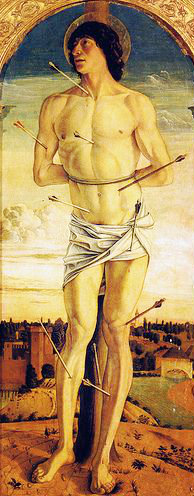| Sitemap | ||
|
|
Giovanni Bellini 1430-1516 Venetian Renaissance Painter Stylistically influenced by the following painters and art styles: Paduan School, Carlo Crivelli, Bartolomeo Vivarini, and Mantegna Education: he apprenticed to his father Jacopo Bellini Cause of Death - Old Age Mediums - oil and sometimes tempura on oak panel  Biography John C. Van Dyke, eminent author and historian remarks "About the middle of the fifteenth century the Bellini family lived at Padua and came in contact with the classic-realistic art of Mantegna. In fact, Mantegna married Giovanni Bellini's sister, and there was a mingling of family as well as of art. There was an influence upon Mantegna of Venetian color, and upon the Bellinis of Paduan line. The latter showed in Giovanni Bellini's early work, which was rather hard, angular in drapery, and anatomical in the joints, hands, and feet; but as the century drew to a close this melted away into the growing splendor of Venetian color. Giovanni Bellini lived into the sixteenth century, but never quite attained the rank of a High Renaissance painter. He had religious feeling, earnestness, honesty, simplicity, character, force, knowledge; but not the fullcomplement of brilliancy and painter's power. He went beyond all his contemporaries in technical strength and color-harmony, and was in fact the epoch-making man of early Venice. Some of his pictures, like the S. Zaccaria Madonna, will compare favorably with any work of any age, and his landscape backgroundswere rather wonderful for the period in which they were produced."At Venice Giovanni Bellini conducted art from the Byzantinism of Crivelli and the Paduan rigidity of Bartolomeo Vivarini into the paths of Botticelli and Perugino. At first he had no individual style, but being of a pliant nature he began following his brother-in-law Mantegna in painting pictures like the Pieta of the Brea, which in its harsh pathos and hard drawing might have been the work of a Padua. After Antonello de messina had come to Venice, Giovanni was the first, under the influence of this Sicilian Netherlander, to adopt the technique of oil painting. Not until he had absorbed these different elements did he become Bellini. Bellini's Madonnas give the impression of entering into a wide and lofty cathedral. All is quiet about, and the sublime figures of his paintings live their serous and lonely existence in solemn grandeur. This solemn ecclesiastical effect is not only produced by placing the thrown of Mary in the mighty apse of the church; but the figures themselves exhale a sort of magic breath of the divine, and appear themselves to possess the sentiment which comes over one when, with bared head, one passes from noise and daylight into consecrated dimness and deep silence of the house of God. -Richard Muther, The History of Painting, Henry and Co., London, 1896 Key Descriptive Words and Phrases associated with the Renaissance Movement - rebirth, rediscovery of the classical world, publication of Della Pittura, a book about the laws of mathematical perspective for artists, sfumato, chiaroscuro, Savonarola, spiritually significant, illuminated manuscript, idealized biblical themes, scriptorium, illuminator, Age of Discovery, axonometric drawing, curiosity about the natural world, realistic use of colours and light, Bonfire of the Vanities, Old Testament stories, ethereal and foggy backgrounds, Gospel parables, The Blackdeath, romanticized landscapes, Christian symbolism. Require more facts and information about the painter and the artists of the renaissance era? Poke around every nook and cranny of the known universe for information this subject. Search Here © HistoryofPainters.com If you like this page and wish to share it, you are welcome to link to it, with our thanks. If you feel you have worthwhile information you would like to contribute we would love to hear from you. We collect essential biographical information and artist quotes from folks all over the globe and appreciate your participation. When submitting please, if possible, site the source and provide English translation. Email to millardmulch@gmail.com References: Richard Muther, The History of Painting, Henry and Co., London, 1896 Giorgio Vasari, The Lives of the Most Excellent Painters, Sculptors and Architects, published in 1550 Wilbur Middleton, Art and Artists, Pilferton and Co., Australia, 1904
|
|